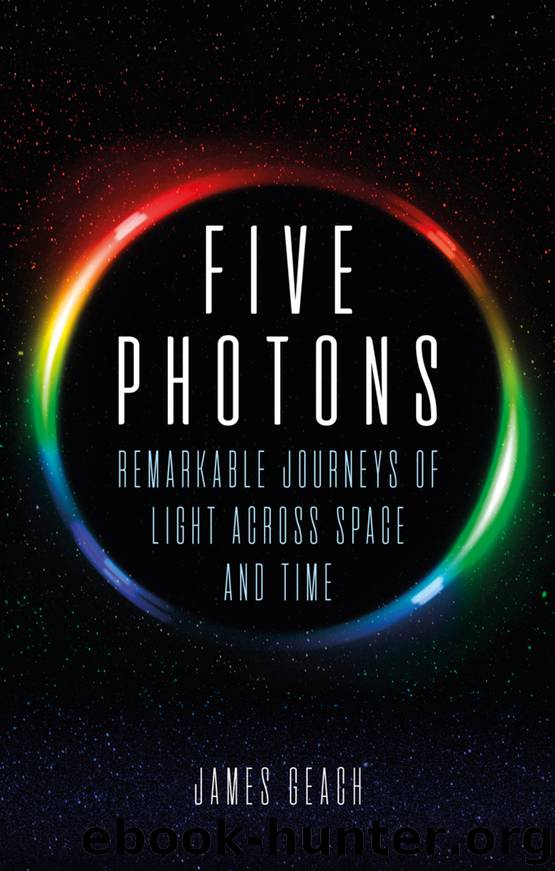Five Photons by James Geach

Author:James Geach
Language: eng
Format: epub
Publisher: Reaktion Books
CCD
A charge-coupled device, or CCD, can be thought of as a two-dimensional array of receptacles that ‘fill up’ with electric charge as photons ‘rain down’ on them.
As more photons hit the detector, further electrons can be promoted in this way, and since electrons have individual negative charge, a bulk negative charge builds up in each pixel. The size of this charge is proportional to the amount of light – the number of photons – hitting the detector. The CCD can be exposed to light for some time to build up an appreciable signal, or up to a maximum point when the charge saturates (the bucket overflows). Once the exposure is finished, the final task is to ‘read out’ the CCD and turn the charge recorded by each pixel into numerical values in an image.
Read-out is achieved though clever electronic structuring of the CCD array that allows the charges in neighbouring pixels to be shuffled along to the edge of the array through the appropriate application of voltages. The charge from every pixel is then sent through a device called an analogue-to-digital converter. This changes the signal into a discrete range of numbers that can be read by a computer. When those numbers are arranged in the same pixel grid pattern as the CCD, we have an image. Although the exact mode of operation of CCDs vary from chip to chip, and are slightly different depending on the wavelength of the light being observed, this general process is the basis of nearly every astronomical image you see.
The most distant starlight we have detected so far – actually the combination of billions of stars – left its galaxy when the Universe was less than five hundred million years old. Some of those photons happened to hit the mirror of the Hubble Space Telescope as it stared for weeks at a single patch of sky. Reflected off the mirror and focused, the photons – now billions of years old – created a small signal in one of its CCD cameras. We see that distant galaxy as a tiny, almost indistinct clutch of pixels just slightly brighter than those around it – they are the whisper of billions of stars carried over space and time.
And that is the fate of some starlight: to hit a telescope mirror and to be reflected and focused onto a camera, finally depositing its energy after what may have been billions of years of flight. That we can actually record those whispers of energy and, more importantly, store that information, is what allows us to explore and understand the parts of the Universe we can never visit. That is the craft of astronomy.
Download
This site does not store any files on its server. We only index and link to content provided by other sites. Please contact the content providers to delete copyright contents if any and email us, we'll remove relevant links or contents immediately.
Tools of Titans by Timothy Ferriss(7816)
Turbulence by E. J. Noyes(7702)
Astrophysics for People in a Hurry by Neil DeGrasse Tyson(5002)
Secrets of Antigravity Propulsion: Tesla, UFOs, and Classified Aerospace Technology by Ph.D. Paul A. Laviolette(4996)
Design of Trajectory Optimization Approach for Space Maneuver Vehicle Skip Entry Problems by Runqi Chai & Al Savvaris & Antonios Tsourdos & Senchun Chai(4844)
Room 212 by Kate Stewart(4739)
Pale Blue Dot by Carl Sagan(4619)
The David Icke Guide to the Global Conspiracy (and how to end it) by David Icke(4383)
A Journey Through Divination and Astronomy by Publishing Pottermore(4250)
Apollo 8 by Jeffrey Kluger(3513)
Goodbye Paradise(3448)
Losing the Nobel Prize by Brian Keating(3425)
COSMOS by Carl Sagan(3350)
The Five People You Meet in Heaven by Mitch Albom(3335)
How to Read Water: Clues and Patterns from Puddles to the Sea (Natural Navigation) by Tristan Gooley(3240)
Brief Answers to the Big Questions by Stephen Hawking(3240)
How to Read Nature by Tristan Gooley(3080)
The Order of Time by Carlo Rovelli(3073)
A Brief History of Time by Stephen Hawking(2819)
